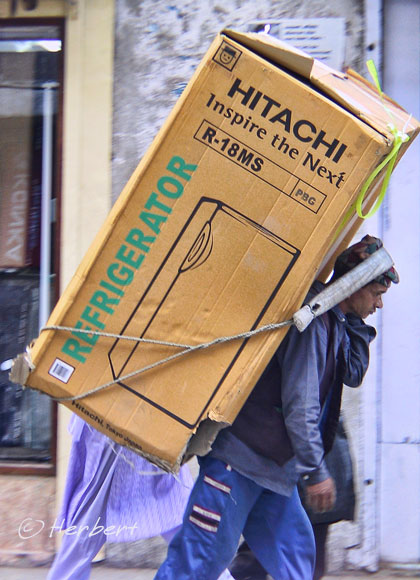
Location: A street stall in Kathmandu, Nepal (27°42'26.99"N 85°18'43.60"E)
Date: 7 May 2003; 3.35pm
Camera: Canon G1



Location: A street stall in Kathmandu, Nepal (27°42'26.99"N 85°18'43.60"E)
Date: 7 May 2003; 3.35pm
Camera: Canon G1

Location: Cemoro Lawang, Java, Indonesia (7° 55' 22" S, 112° 57' 52" E)
Date: 15 July 2008; 6.45pm
Camera: Canon 400D with Sigma 17-70/f2.8-4.5
Cemoro Lawang is a small town at the rim of the Bromo caldera. Its location makes it the most convenient and sought-after base for visiting the Bromo-Tengger-Semeru National Park. As a result, tourism is the major economic activity. However before tourism became a major money-spinner, farming was the main productive activity in this town and the surrounding area. The land around here is extremely fertile, benefiting from the volcanic ash of the few volcanoes in the vicinity. All the farms, which are small family-plots grow vegetables. As is the norm in most farming and rural communities around the world, the people here are super-friendly and hospitable.
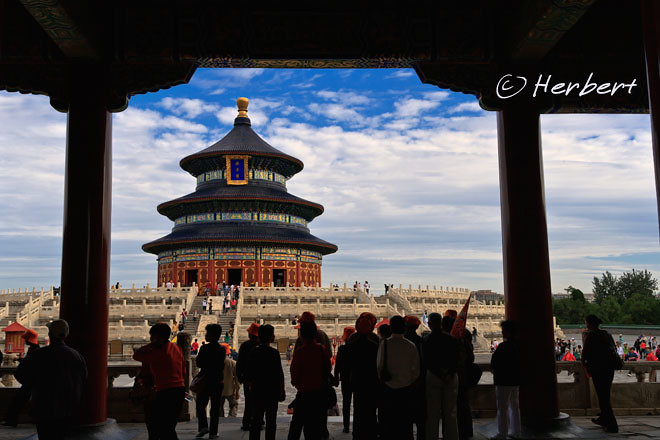
Location: TianTan, Beijing, China(39° 52′ 56.07″ N, 116° 24′ 23.29″ E)
Date: 18 October 2010, 9.50am
Camera: Canon 500D with Sigma 17-70/f2.8-4.5
To most people, the Great Wall of China with the most accessible portion situated on the outskirts of Beijing, is the most recognisable icon of China. However as far as Beijing is concerned, its icon is actually the TianTan or loosely translated as the Temple of Heaven; more accurately Altar of Heaven. This is where the emperors of the Ming and Qing Dynasties came to make offerings and pray for bountiful harvests every year. In the psyche of the Chinese, TianTan held another significance as it represented a symbol of an era of shame when China was forced into signing away sovereignties in unequal treaties with the West under the barrel of canons. The temple complex was occupied and used as a command centre by the Eight Nation Alliance during the Boxer Rebellion resulting in serious desecration and damage to the temple, buildings and gardens. Many temple artefacts were also looted by the Alliance soldiers. the temple and buildings were constructed during the Ming Dynasty but underwent large-scale renovation during the Qing Dynasty. As a result, Qing decorations and adornments predominates in the temple. Today TianTan is a major tourist destination.

Location: Hundar, Ladakh, India (34°37'12.63"N 77°25'51.76"E)
Date: 16 August 2009 5.15pm
Camera: Canon 400D with Sigma 17-70/f2.8-4.5
Hundar is as close as one can gets to the disputed Line of Control between India and Pakistan in India Kashmir. Pakistan is so close, it is virtually just across a bridge in the northern end of the small village. As such this place in the Nubra Valley has a heavy military presence. Hundar is popular and well-known to some extent as the location of the world’s highest altitude sand dunes, at approximately 3,120m. The sand dunes are not that spectacular but attracts a lot of tourists on packages. There are more interesting wanderings to be had at the village proper. Stupas and gompas, old and new dotted the village, some prayer wheels and fabulous views across part of the Nubra Valley. As in most parts of Ladakh, getting to the destination is the adventure and the fun part. Independent travellers have no chance of coming here without chartering (sharing better) a vehicle with others.

Location: Paris, France (48°51′39″N 2°20′09″E)
Date: 26 February 2006; 1.25pm
Camera: Canon 300D with kit kens
Independent traveling is a fun way to travel for me. Often I get to see many unexpected places and interact with all sorts of interesting people. This mode of traveling needs a bit more planning and is also more time-consuming as most of the time I have to rely on local transport, whatever there might be. In some countries such as China, this is not a problem as there is a myriad of transport options available, from the publicised train and bus services, to chartered, hitch-hiking and sharing of transport with other travellers. One can virtually get to any secluded corners with a little effort. The same goes for countries such as Pakistan and India. I guess this is a factor of rural hospitality and poverty which makes people more willing to share and help others. This is not the case with more developed countries- in such countries such as USA and most parts of Europe, public transport is only good to bigger cities. Outlying places are not easily accessible by public transport. This is also due to the fact that most people in such countries own their own transport; so the demand and hence, supply for services to more secluded destinations do not exist. Even if options are available such as joining a local tour, these are always only good for the casual look-see, been-there-before type of sightseeing. Renting a car, often is the most feasible option to travel to rural, outlying and secluded places in these countries.
If you are lying from the UK and need to drive to the airport you are stuck with the problem of where to leave your car. Try Gatwick Parking if you are flying from London. Or if you are flying from the North, try parking at Manchester Airport.

Location: Mekong River, Luang Prabang, Laos (19°53′N 102°08′E)
Date: 2 November 2004; 6.05pm
Camera: Canon 300D with kit lens
I have a certain fascination with the mighty rivers. Whenever I visit a country where a trans-national great river flows through, I will make it a point to see the river, be it in Africa or Asia. Maybe it is the importance that I learnt of rivers/water’s role played in civilisation and development of nation and humanity. Perhaps it is just the satisfaction of able to see different stages of the same river in different settings, environments and countries. For example, I saw Lancang Jiang in Tibet and Yunnan of China and also its manifestation as Mekong River in Laos, Vietnam and Thailand. Similarly I went to the source of the Indus River in Tibet and travel along its course on parts of the Karakorum Highway in Pakistan. I saw Yarlung Tsangpo Jiang in many parts of Tibet but will love to see it emerge as the Brahmaputra River in India and Bangladesh- one day. The Yangtse River flows only within China but it changes directions and characters, not to mention its name many times while it courses through China before dumping its water into the South China Sea. It is hard to imagine that any of these mighty rivers may disappear soon due to global warming when one is looking at its might and majesty, but the sciences are telling us just that. So make sure you take another good look at the great rivers the next time you are on their banks because they may not be there or the same when you next revisit the same spot.

Location: Mount Cook, South Island, New Zealand (43° 35′ 44.69″ S, 170° 8′ 27.75″ E)
Date: 27 May 2009, 8.40am
Camera: Canon 400D with Sigma 17-70/f2.8-4.5
New Zealand is blessed with some of the most beautiful landscapes in the world, within a small area. Hence it is very easy to enjoy the diversity of sceneries without travelling too far away. This results in, perhaps, a nation with one of the most outdoor-oriented citizenry. Everywhere one turns, there are opportunities to engage in the great outdoors, be it mountaineering, skiing, fishing, hiking, canoeing, you name it. No wonder a country with such a small population excels in so many sports, as evident by the number of world beaters in so many disciplines- rugby, sailing, canoeing and so on. Of course, not forgetting Edmund Hillary. In fact, Mount Cook or Aoraki (see this post) is where the first conqueror of Qomolomgma or Sagamartha or Mount Everest (to the layman) hone his alpine skills.
The accessibility of such wonderful pristine landscape is also one of the reasons that NZ is such a favourite destinations for many travellers. One need not be a mountaineer or outdoor specialist to get close to some of the most amazing landscape or wilderness.
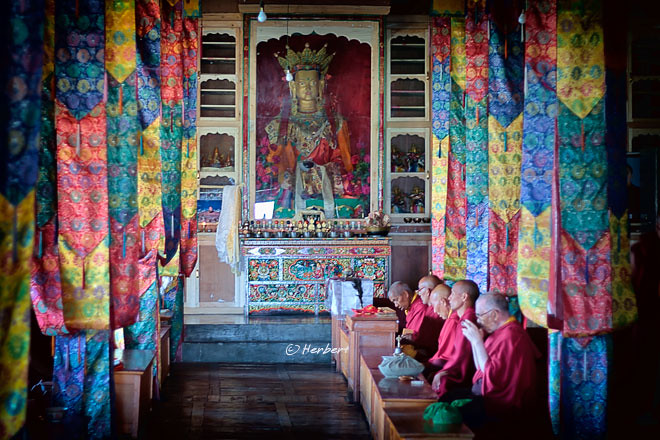
Location: Diskit Gompa, Nubra Valley, Ladakh, India (34° 32′ 28″ N, 77° 33′ 37″ E)
Date: 24 August 2009 7.50 am
Camera: Canon 400D with Sigma 17-70/f2.8-4.5
I have wrote that Ladakhis have Tibetan features. They also share similar ancestry and religion. By and large most ethnic Ladakhis practice Tibetan Buddhism with similar Yellow, Red etc sects just as in Tibet. Their gompas and traditions are similar. Anyone who have spent some time in Tibet could easily mistakenly think that they are in Tibet after spending a few days in Ladakh.
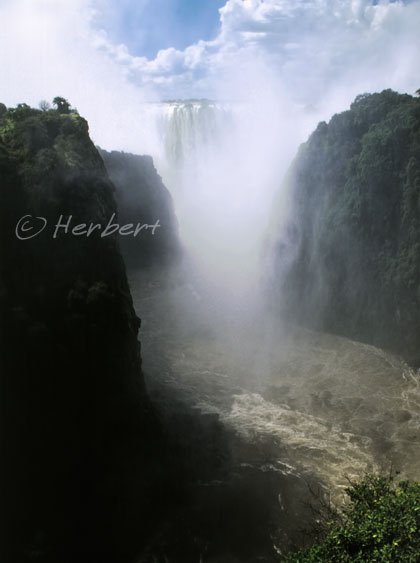
Location: Victoria Falls, Zimbabwe, Africa (17° 55′ 28″ S, 25° 51′ 24″ E)
Date: 5 April 2001; 5.10pm
Camera: (analogue) Canon 500N with slides and scanned
The names of too many great landmarks around the world had been “hijacked” or “christianised” by the Western powers in a bygone era when countries of the Western hemisphere were the strongest (militarily and economically) on the planet. Such landmarks have their local names but were renamed after some Western figures when they were “discovered'”. These are really great insults to the people of those lands as these landmarks are known to them for generations and they do have names for these places centuries before any Westerner had set sight on them. Yet such foreigners had the guts to claim that they discovered such places. The so-called Victoria Falls were known as Mosi-oa-Tunya in the local Kololo language of the Zambians before any white people ever set foot on the black continent. Similarly, Mount Everest had always and will forever be Sagarmatha to the Nepali Sherpas or Qomolongma to Tibetans, whatever the the rest of the world has gotten used to called it. For that matter, the Baltis only know Chogori as the name of the world’s 2nd highest mountain, not K2 as coined by the British in the 19th century. The might of the West is waning, epitomised by the EU seeking out China’s help in the Euro crisis, amongst others. It is about time to return justice and respect to local cultures of many of the world’s great places by at least using their proper and historical names. NZ leads in this respect by reverting to using both Maori and common English names to many of their nature wonders such as Aoraki for Mount Cook and Manahuna for McKinnon Pass.
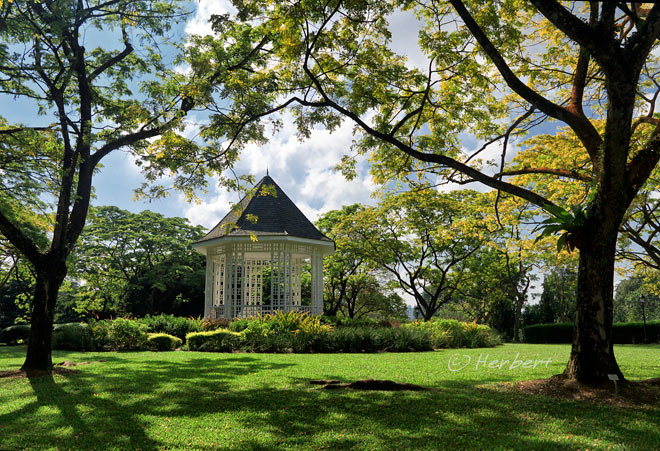
Location: Bandstand, Singapore Botanical Garden (1°19'18"N 103°48'59"E)
Date: 8 October 2011; 9.50am
Camera: Canon 400D with Sigma 17-70/f2.8-4.5
Singapore Botanical Garden is one of the main attractions of Singapore. Quite often when one lives in a place, one easily overlook the local attractions that tourists from far afield come to visit. The Botanical Gardens is just one of those- I lives in Singapore but never pay much attention or visit the place unless I have visitors. However it is apparently a favourite of tourists especially the new force-to-be-reckon-with tourists from China and India. These tourists are no doubt attracted by the immaculately maintained gardens and its vast collection of tropical trees, flowers and plants. For locals, one of the favourite spot of the Gardens is the white octagonal shaped pavilion named the Bandstand which was erected in 1930. The Bandstand used to host military band performances in the past- now it is a popular spot for newly-weds to have their photos taken with their full regalia of wedding gowns.
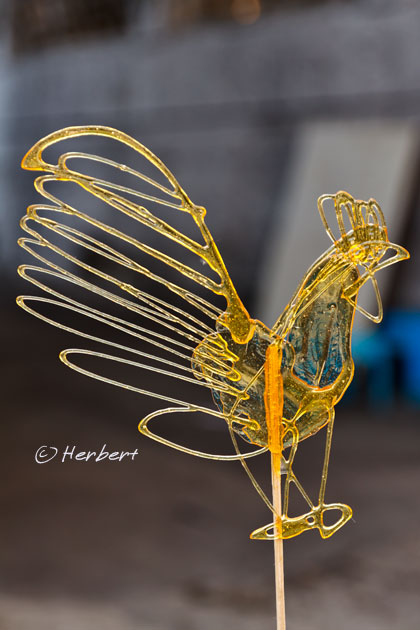
Location: Gulangyu Island, Xiamen, Fujian, China (24° 26′ 51.43″ N, 118° 3′ 44.83″ E)
Date: 17 December 2008; 10.50am
Camera: Canon 400D with Canon 70-200 f/4 L IS Lens
If one goes to any major cities in China, one will not feel too out of place as in any other major Asian cities. The country is virtually galloping into the 21st century, at least as far as urban infrastructure and architecture is concerned. That’s why, apart from the mega and very important cities such as Beijing and Shanghai, all the Chinese cities look rather similar in the type of buildings and layout. One of the consequence of this mad rush to modernise is the tearing down of anything that stands in the way- not just physically but culturally as well. Many of the cultural heritage of this 5,000 years of continuous civilisation is fast disappearing together with its rich architecture heritage. Traditional dances, costumes, practices, arts and crafts as well as ethnic dialects are slowly dying. Ironically some of such cultural heritage are still maintained as a result of the creeping commercialism from tourism. Arts such as the face changing technique of Sichuan opera and Naxi traditional music survives mainly because there is demand for such arts performances for tourists. Similarly in smaller scale, traditional arts such as flour dough figurines and candy sculpture (as in photo) still flourished as novelties for tourists.
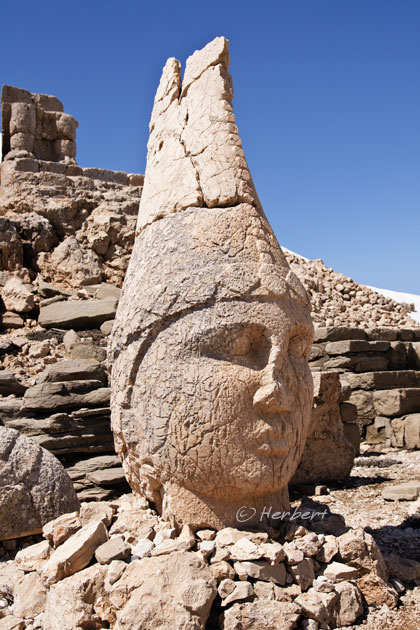
Location: mount Nemrut, Turkey (37° 58′ 54″ N, 38° 44′ 28″ E)
Date: 17 April 2010, 8.40am
Camera: Canon 400D with Sigma 17-70/f2.8-4.5
The fallen large head statues of the royal tomb atop Mount Nemrut (or Nemrut Dagi) in southwestern Turkey must be the most iconic symbols of Turkey after the minarets of its mosques in Istanbul and its Whirling Dervish dances. The site of the tomb is not easy to get to, if one is traveling independently as there is no transport that goes up the mountain. There are buses that go part of the way (for about 8 months of the year) and travellers will have to either hike or hitch a ride. As is the norm for such summit destinations, most travellers would want to get there for the sunrise or sunset. Accommodation options and quality for such activities are very limited- there are a few hotels at the base of the mountain but they are mainly tailored and frequently reserved for packaged groups. Nonetheless it is a worthwhile effort to visit this tomb if one visits Turkey. Apart from the surreal setting and the statues, the view from the summit is a bonus.

Locations: Zhaoxing, Guizhou, China (25° 54' 39 N 109° 10' 35 E).
Date: 18 April 2005; 11.15am
Camera: Canon 300D with kit lens
The Dongs are one of the minorities predominant in Guizhou province of China. They are well-known for their Wind & Rain Bridge as well as Drum Tower. Unlike the big minorities, Tibetans of Tibet and Uighurs of Xinjiang, who were in fact the ethnic people of their provinces, Dongs were never an ethnic group of significant numbers. Ironically because of their smaller numbers, the Chinese Hans had been less zealous in trying to assimilate them into the Chinese culture, so to speak. In any case, as a result of their smaller numbers, they are more inclined to adapt to the Han culture. This is not to mean that they have abandoned their cultural heritage; however, the Dongs felt less threatened by the encroachment of Han into their space. Part of this is also economics- the Tibetans and Uighurs’ homeland are rich in many resources- the other minorities inherits less of such benefits. Managing the major minorities will continue to be a huge challenge for China until they realised and accept that the minorities are different and want different things (not chiefly development) from the central government.
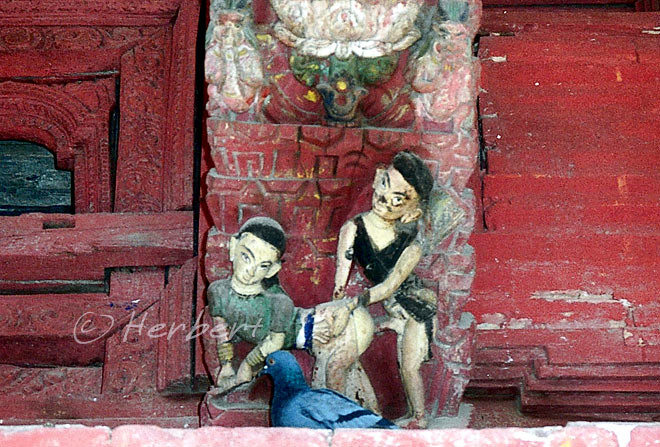
Location: Basantapur Tower, Durbar Square, Kathmandu, Nepal (N27 42 14 E85 18 30 )
Date: 28 March 2000; 2.10pm
Camera: Canon EOS 500N (analogue) on slides and scanned
Eroticism, to be exact erotic art, is prevalent in Hinduism. One can see that in many ancient Hindu temples, the most famous of which is the Khajuraho temple complex. Many people find this rather amusing and really puzzling as most other religions refrain from things sexual, explicitly. It shouldn’t be as Hindu erotism is simply an expression of the religion (as well as other religions)’s belief in a different perspective. Like any other religions, Hinduism is a prescription or way of life according to certain codes and beliefs. The final aim of a Hindu is (no surprise) salvation, which is the merging of the individual soul with that of the supreme soul. The pursuit of pleasure or kama is an important aim of life, on the way to deliverance or attainment of salvation. As such, figures of loving couples or “mithuna”, in sexual pose and sex acts, are no taboos or attract any inhibitions, as any other life processes. In fact, worship of Shiva’s lingam (penis) is part and parcel of Hinduism. All of these manifest in many art forms, including sculptures from very early on in Indian civilisation.
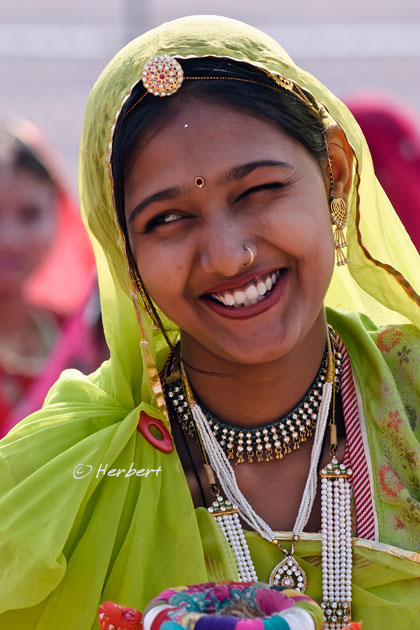
Location: Bikaner, Rajasthan, India (28° 1′ 0″ N, 73° 18′ 43″ E)
Date: 10 Jan 2009; 3.40pm
Camera: Canon 400D with Canon 70-200 f/4 L IS Lens
Indian women are amongst the most beautiful women of the world. Indian beauties have captured the world’s imagination ever since Aishwarya Rai won the Miss World pageant in 1994 and went on to become a Bollywood star. In fact Bollywood movies are instrumental in bringing the world’s attention to India’s beautiful women. Many of the more well-known and popular Bollywood top ladies are of Northern Indian descent, with fairer skin tone and higher cheekbones ala Aryan features. However Indian women from other parts of the country are just as charming and attractive in their own ways. For example, Rajasthani ladies are not only pretty but are also graceful.
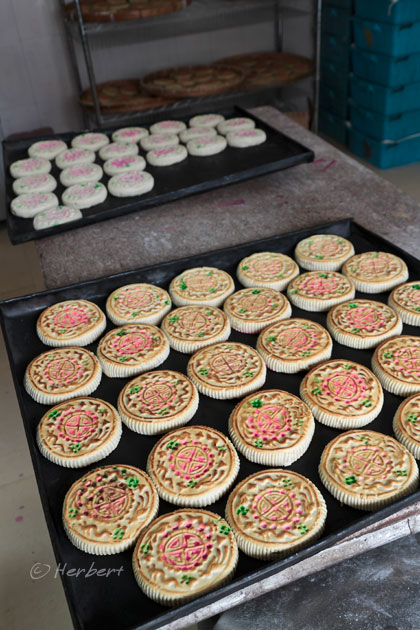
Location: Xiapu, Fujian, China (23° 46' 20" N, 117° 2' 47" E)
Date: 16 December 2008; 10.50am
Camera: Canon 400D with Sigma 17-70/f2.8-4.5
It is said that there are 3 main events in a person’s life: birth, marriage and death. All these 3 events are celebrated or commemorated in grand fashion by all the different cultures of the world. With the exception of death which is either celebrated as a joyful occasion in some cultures or a sad passing in others, birth and marriage are always joyous moments in virtually all cultures.
Marriage is a huge celebration amongst all the ethnic groups in China. Furthermore marriage is celebrated in different manners even within the different Chinese regions of Han population. Many of them involves the giving of marriage cookies to relatives as part of the celebration. In the coastal towns of Fujian like Xiapu, a colourful, beautiful and tasty wedding cookie is one of the must-haves for a marriage. The cookie is baked with a filling mix of sesame, sugar, nuts and other contents which I do not really know but tastes fabulous, nonetheless.

Location: San Saeb Jetty, Bangkok, Thailand (13° 44′ 49″ N, 100° 32′ 23″ E)
Date: 18 September 2011; 7.35pm
Camera: Canon 500D with Sigma 17-70/f2.8-4.5
Bangkok used to be known as “Venice of the East'” as it used to be filled with canals. Residents used to live on water while carrying on their daily activities by boats- and boats were the major mode of transportation. In the last 10 over years, many of these canals were filled to make way for new roads and buildings. However many of these old canals still remain on the Thornburi side of the Chao Phraya River. People still carry out their day-to-day life along these canals here- floating residences, postmen delivering mails and vendors hawking their wares on boats. Even monks do their alms rounds on boats- that’s also because many of the historically old temples are still situated along these canals. Back in the east bank of Chao Phraya (or “Bangkok proper”) the importance of canals had diminished but not disappeared. There are still many canals served by long boats. This is still an important mode of transport around the city as water transport beats the city’s notorious traffic jams.
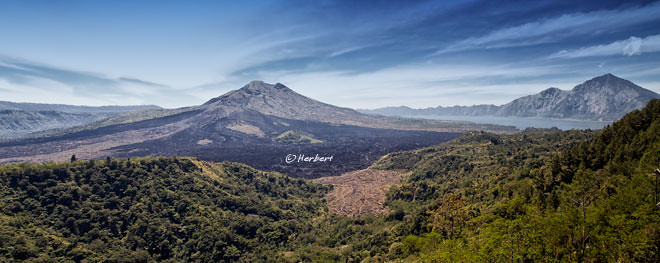
Location: Gunung Batur from Kintamani , Bali, Indonesia (8° 14′ 31.2″ S, 115° 22′ 30″ E)
Date: 28 August 2011; 12.15pm
Camera: Canon 400D with Sigma 17-70/f2.8-4.5
Gunung Batur is one of several active volcanoes on the island of Bali. It has 2 calderas and a beautiful lake. The area is a popular tourist destination. The area around here is very fertile and there are 2 villages at the foot of the volcano. People in Indonesia are used to living under the constant threat of volcanic eruptions from the hundreds of active volcanoes spread all over the archipelago. Volcanoes are both feared and revered as abode or manifestations of divinity. Furthermore volcanoes are revered for giving fertility to the surrounding area (from its lava). That’s why despite the danger, volcanic areas are still highly populated- and that’s why volcanic eruptions in Indonesia invariably cause big death toll.
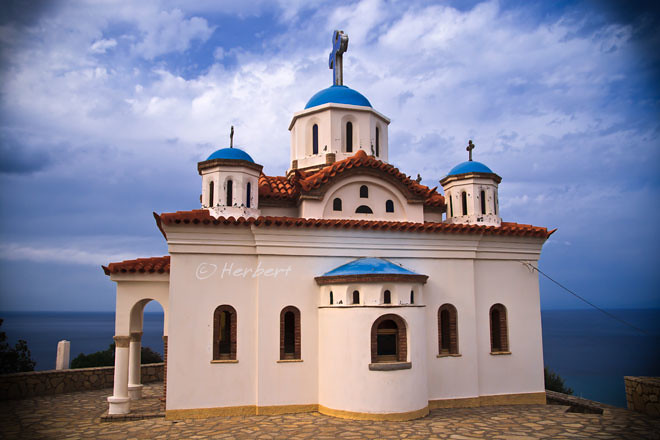
Location: Samos Island, Greece (37° 44′ 0″ N, 26° 50′ 0″ E)
Date: 3 April 2010; 3.35pm
Camera: Canon 400D with Canon 70-200/f4L USM
At the moment Greece is in the dump economically. I wonder if things has gotten cheaper in the country. When I visited the country a year or so ago, I was surprised to find that it is much more expensive than Turkey- due partly to the fact that it is Euro-based. However I was already wondering to myself as I noticed that the Greeks (at least the ones that I encountered) do not seem very motivated to work hard for a living. This feeling is especially pronounced to me, having just spent a few weeks in Turkey- the Turks just seem to be more hungry. Little did I realised that this appearance foretells a bleak economic reality. In any case, as a tourist I enjoyed its unique character and its rich cultural and historical heritage. I find its unique Mediterranean architecture extremely exciting- such as this church on Samos Island.
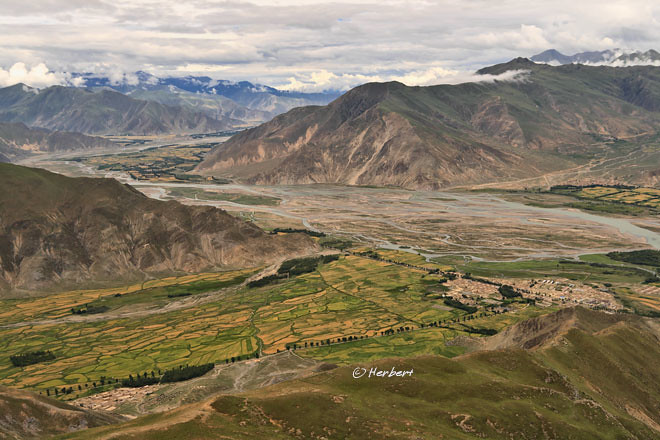
Locations: Lhasa Valley, Tibet, China (29° 45′ 28.8″ N, 91° 28′ 30″ E)
Date: 10 August 2007; 9.0am
Camera: Canon 400D with Sigma 17-70/f2.8-4.5
I have to consider myself lucky as far as traveling to Tibet is concerned. I did 3 trips to Tibet between 2003 and 2007 and went to a fair number of places that the Chinese government forbids foreigners to visit. Some of the landscapes and tradition/culture of the people I met and visited are etched forever in my memories. I am lucky because the Chinese government has closed off more and more of the province to foreigners for political and information censorship reasons. In any case, the Han Chinese are changing Tibet so dramatically and so quickly that the character and spirituality of many wonderful places in Tibet are just no longer the same- in some ways one can say the same of the whole of China. Hence I consider myself lucky to be able to experience the magic of these places and their people before their modern and developmental transformations.
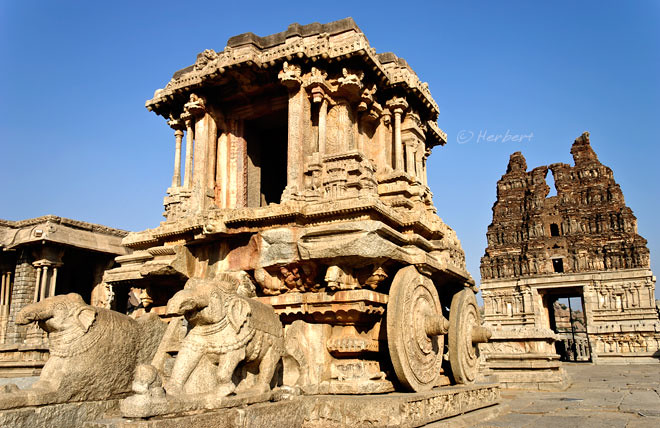
Location: Vittala Temple, Hampi, Karnataka, India (15° 20′ 6″ N, 76° 27′ 43.2″ E)
Date: 29 November 2005; 1.30pm
Camera: Canon 300D with kit lens
Hampi in Karnataka should be a destination on every visitor to India. It is an atmospheric village strewn with huge boulders traverse by a river. It is both scenic and strange at the same time. Perhaps the most famous of the ruins in Hampi is the Vittala Temple with its iconic stone chariot, which has been adopted as its symbol by the Karnataka Tourism. The chariot resembling a ratha (or temple chariot) in which temple idols are taken out on traditional processions, is actually a miniature temple. Contrary to popular legend, it was not carved from a single rock. Regardless it is still an amazing piece of ancient art- complete with four round stone wheels.
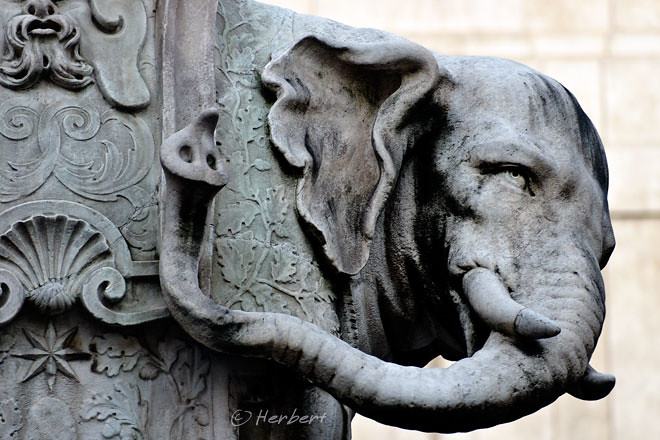
Location: Rome, Italy (41° 53′ 24.61″ N, 12° 29′ 32.17″ E)
Date: 2 April 2005; 3.20 pm
Camera: Canon 300D with kit lens
Rome is a city filled with surprises everywhere one turns. Apart from the huge number of churches and fountains, there is history everywhere. Beautiful sculptures adorned every other buildings and undoubtedly most of them would have been from a very early age. If one does not record down what and where, there is simply no way of remembering what one sees in the city. I think I saw this elephant head sculpture at the front facade of a boutique hotel but then I just cannot be sure- there are so many beautiful sculptures at every corners!!

Location: Pinnacles of Gunung Api, Gunung Mulu National Park, Sarawak, Malaysia (4° 7′ 55.2″ N, 114° 55′ 8.4″ E)
Date: 14 November1995; 8.20am
Camera: (analogue) Canon EOS 500N on negatives and scanned
Gunung Api, popularly known as the Pinnacles is situated within the UNESCO heritage site of Gunung Mulu National Park in Sarawak. It is known as Pinnacles due to its striking smooth razor-edged limestone karst formations, resulting from water erosions over the centuries. The mountain itself is not very high- most of the more spectacular pinnacle formations are close to the summit but not necessary to reach the summit itself. However it can be a rather tough ascend up the mountain to enjoy the stunning views. The ascend is steep at various places and is punctuated by ravines caused by the erosion of the limestone structure of the mountain. The Park Rangers had secured metal ladders, laid out flat, connecting the top of limestone pillars to negotiate such ravines. Visitors should be prepared to go on fours while walking on such ladders. Any visitors to the Mulu National Park itself should attempt to spend a few more days to marvel at this wonder and savour the real sense of achievement and adventure on reaching the destination.
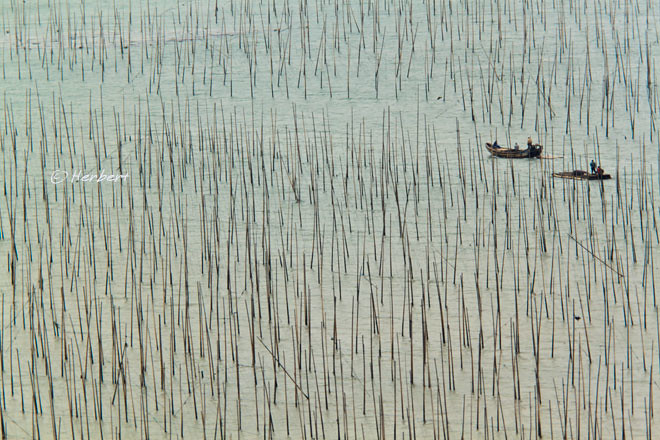
Location: Xiapu, Fujian, China (23° 46' 20" N, 117° 2' 47" E)
Date: 14 December 2008; 1.50pm
Camera: Canon 400D with Canon 70-200 f/4 L IS Lens
These days there are not too many exquisite places in China which are not swamped by tourists. More often than not, fabulous destinations are crowded with China tourists rather than foreigners. The main reason is of course, Chinese are getting wealthier and is more prepared to spend money traveling around their own country. On top of that, it is difficult for them to travel outside of China, without being part of a tour group or on official business. Another reason for such a phenomenon is the speed of news spreading via internet- and China has the world’s biggest internet population; hence news and reviews of any exciting new destinations will be known by many very quickly. An example is a small coastal town, Xiapu, in northern Fujian. Apart from some photography enthusiastic from Hong Kong and Taiwan, really only Chinese know of this sleepy town. The town’s main attraction to tourists is the scenery around the few coastal villages within a 20km radius. Such villages engaged in various aquaculture activities such as seaweed and oyster cultivation, fishing and so on. They are pretty and charming especially during the various harvest seasons with all sorts of activities on the coastlines. During the high season, droves of Chinese photography enthusiasts flock to this town, using it as a base- and there are only Chinese. Very, very few foreigners would even have heard of this place- so much so that there are only 1 or 2 hotels in town that are officially registered/allowed to offer accommodation to foreigners.

Location: Kek Lok Si, Penang, Malaysia (5° 23′ 58.29″ N, 100° 16′ 25.43″ E)
Date: 8 August 2011; 11.20am
Camera: HP Compact Camera SB360
Georgetown of Penang together with Melaka was awarded a UNESCO Heritage status, both being dubbed "Historical Cities of the Straits of Malacca ’s a couple of years ago. The town’s main claim to the UNESCO status was its amazing web of still enormous number of colonial buildings, churches, government buildings, temples and still-inhabited pre-war shops and houses as well as art-deco structures. The town is a living testimony to the multi-cultural heritage and tradition of Asia, and European colonial influences. In the “old-town” area, which incidentally is still the major chunk of Georgetown, one can spot an architectural and cultural gem in virtually any corner one turns, be it beautifully and lovingly refurbished heritage mansions or living clan temples and schools. The amazing thing about Georgetown is that it is a truly living old town where in very few exceptions, people still lives a normal life in these old buildings and structures. Life still goes on unchanged for the majority of the inhabitants despite the UNESCO award; unlike Melaka where one feels a distinctly commercialised and touristy atmosphere as businesses cash in the UNESCO status.
Penang is not only Georgetown as there are many other interesting tourist destinations on the island, including Kek Lok Si (Temple of Supreme Bliss), the largest Buddhist temple in South East Asia. Furthermore Penang is truly a food heaven, where its distinctly Penang Hawker Food is famed all over Asia. I will have a couple more posts on Penang in the next few days.

Location: Colosseum, Rome, Italy (41° 53′ 24.61″ N, 12° 29′ 32.17″ E)
Date: 3 April 2005; 8.20 pm
Camera: Canon 300D with kit lens
The Colesseum is one of the most recognisable building of Italy and apparently the top tourist attraction in Rome. It is not difficult to understand as there are so many stories and legends abound about the Colosseum, not least movies and TV series about gladiatorial duels held in the Colosseum during the Roman Empire. It attained further notoriety associated with the martyrdom of Christians in the Colosseum by crucifixion and then fame as the starting point of every year’s Good Friday torchlit procession by the Pope.
The Colosseum is actually not that big; I guess is is the same imagery everyone have of well-known places and reaction when in its presence. In fact it is in a state of ruin and quite meaningless if one visits the place without a proper guide.
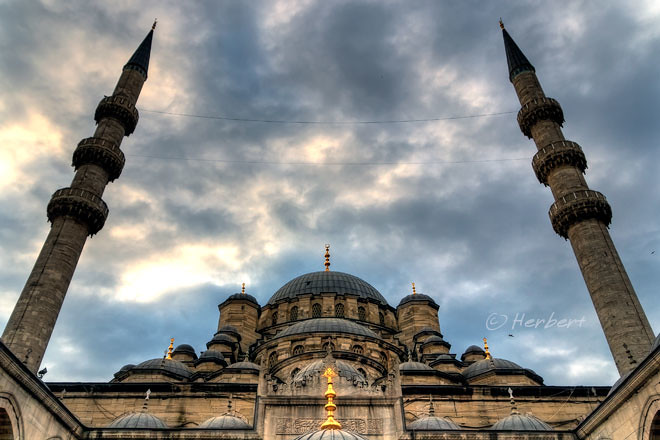
Location: Yeni Camii, Instanbul, Turkey (41° 1′ 1.25″ N, 28° 58′ 17.3″ E)
Date: 21 April 2010, 8.10am
Camera: Canon 400D with Sigma 17-70/f2.8-4.5
Yeni Camii is know as the New Mosque. However it is not new at all, being inaugurated in 1665. It took about 4 decades to build the mosque, mainly due to funding and water seepage problems. The mosque is in the style of Turkish mosque with big courtyards, domes and minarets. It may not be the most well-known or popular mosques on the tourist map, but it is definitely one of the most beautiful one in Istanbul. I felt that one of the reasons that I labelled it as most beautiful is due to its outstanding location on the water edge beside the Galata Bridge.
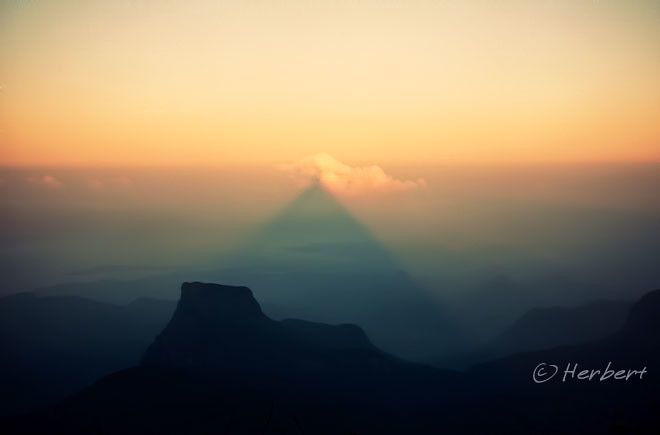
Location: Adam’s Peak’s shadow, Sri Lanka (6° 48′ 41″ N, 80° 29′ 59″ E)
Date: 3 March 1997; 6.15am
Camera: (analogue) Minolta compact with negatives and scanned
Adam’s Peak is the 4th highest peak in Sri Lanka. It is revered as a holy site by Buddhists, Hindus, Muslims and Christians. It has a 1.8m rock formation at the summit that resembles a footprint- the Buddhists regard that to be the footprint of Buddha, the (Hindu) Brahmans as that of Lord Shiva, the Muslims as that of Adam and the Portuguese Christians have conflicting claims that it is the footprint of St Thomas and the eunuch of Candace, the queen of Ethiopia. As such it is a popular and important pilgrim site. There are several routes to the mountain, involving walking up thousands of steps. Pilgrims normally starts very early in the morning so that they can be at the summit at sunrise to see the distinctive shape of the mountain casting a triangular shadow on the surrounding plain which can be seen to move quickly downward as the sun rises. In fact the walk up the summit during the wee hours of the morning itself can be quite a sight with the zigzag path leading up to the summit lit up by the lights of pilgrims.
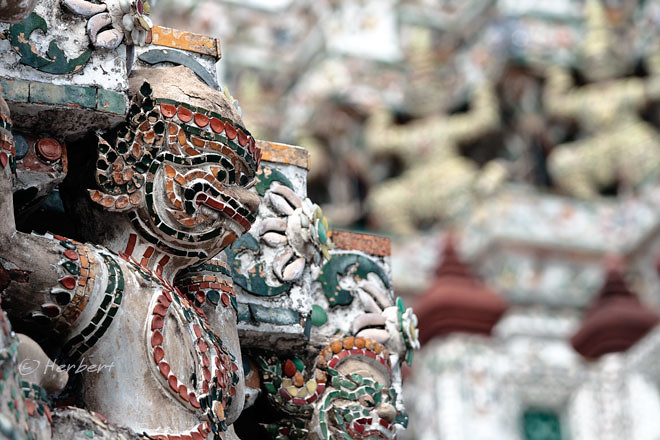
Location: Wat Pho, Bangkok, Thailand (13° 44′ 47″ N, 100° 29′ 37″ E)
Date: 24 June 2010, 1.15pm
Camera: Canon 400D with Canon 70-200/f4.0
Bangkok is a city with lots of attractions- enough to keep a tourist busy for 3-5 days, if one is not sick of wats (temples) yet. On top of the wat-hopping, One can go crazy shopping at the various cheap shopping centres in Pratunam etc as well as the numerous nights markets and the giant Chatuchak weekend market. Currently Thailand is facing a bit of a lull period as there are uncertainties and hence, anxieties of tourists travelling to Thailand resulting from the election. That is all past and hopefully, things will return to normal for the “Land of Smiles” and keep the people smiling.
One of my favourite wat in Bangkok is Wat Pho. Not only that it has a huge and majestic reclining Buddha, there are also a few Thai chedis decorated with flower motifs and Thai mythical creatures in tiles (pictured). These are really attractive. Furthermore if one is tired of the walking, there is a massage school within the compound that provide massage services.
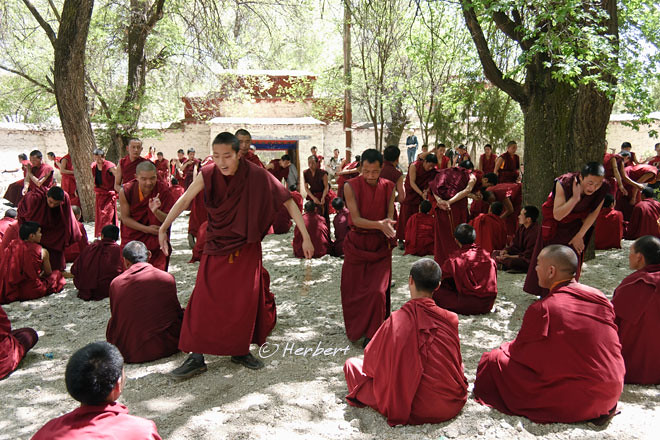
Locations: Sera Gompa, Lhasa, Tibet, China (29° 41′ 53″ N, 91° 8′ 0″ E)
Date: 18 May 2005; 5.50pm
Camera: Canon 300D with kit lens
Any visitors to Lhasa must visit Sera Monastery, which is within Lhasa limit at the northeast corner of town. One can easily get there by public bus. There are several reasons to visit this monastery including its historical and religious significance and the size and expanse. However one good reason to visit it is to witness the daily Scripture Debate by the resident monks. The monastery had developed over the centuries as a place of scholarly learning with many famed monks in Tibetan Buddhism having trained here. Everyday around 3pm, the resident monks will gather in the garden within the compound of the monastery to debate Buddhist scriptures and philosophy. The debates are punctuated by physical gestures such as hands clapping after each question, loud screaming and verbal exchanges that tremendously enliven the ambience of the debates. Some of such gestures may seem so violent that it may appear to an uninformed observer that the monks may be having a heated argument. These debates make this monastery a special experience.
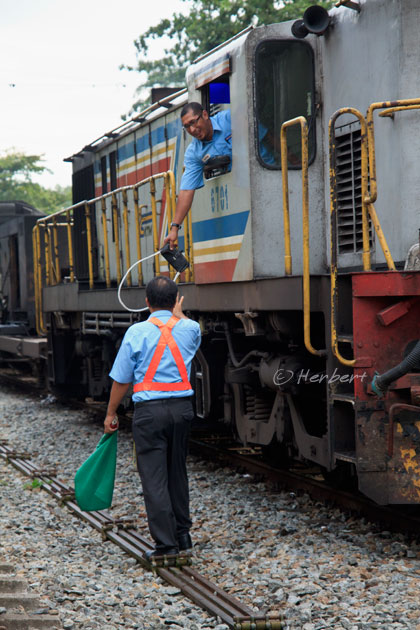
Location: Bukit Timah KTM Railway Station, Singapore (1° 20′ 3″ N, 103° 46′ 52″ E)
Date: 29 June 2011, 5.35pm
Camera: Canon 400D with Sigma 17-70/f2.8-4.5
Most independent travellers to Malaysia who have been to destinations other than the main cities would have take a ride or two on Malaysia’ railway run by KTM. In fact most travellers traveling to Singapore from Malaysia would have taken the train ride into the city-state because of its convenience- the journey terminates right at the Tanjong Pagar Station in the heart of the city, at the edge of the Central Business District (CBD). Well, that is no more as the two countries implemented a landmark agreement that resulted in the moving of the terminus station to right at the border between the two countries. As a result, rail travellers will find it less convenient to get to the city from the new terminus station. Alongside the ending of the KTM route within Singapore is the discontinuance of a couple of old-world railway operations that were still practised in Singapore by KTM. This includes the exchange of key token (as pictured) between the train driver and station master, bestowing the authority to the train to enter into the next sector of the railway track. This is a safety measure designed to prevent head-on collisions as the entire route is on a single track. On top of this is the disappearance of the manually operated signalling system.
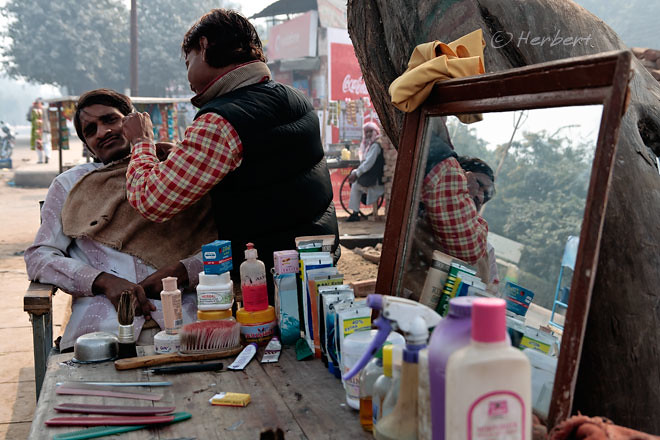
Location: Agra, Uttar Pradesh, India(27° 10′ 48″ N, 78° 1′ 12″ E)
Date: 7 Jan 2009; 3.10pm
Camera: Canon 400D with Sigma 17-70/f2.8-4.5
India is one of a few countries where there is a healthy mix of the old and new. One example is the continue use of colonial era articles. Another very interesting sight is the continue practice of trade in the old fashion way alongside the modern version, be it laundry and ironing services or hair-cut. These days there are swanky air-conditioned saloons in cities such as Mumbai, Delhi and so on; but roadside barbers are doing popular.
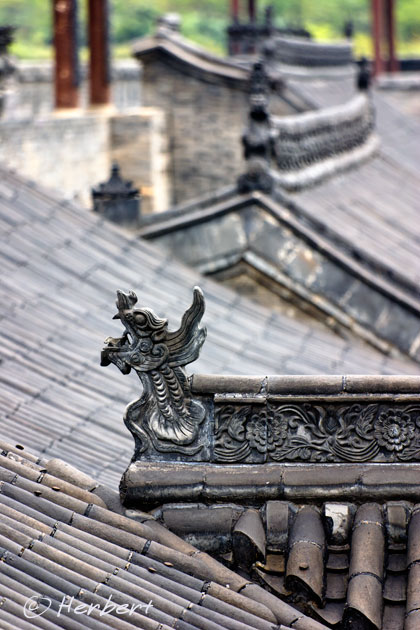
Location: Pingyao, Shanxi, China (37° 12′ 5″ N, 112° 9′ 16″ E)
Date: 10 October 2008; 2.50pm
Camera: Canon 400D with Canon 70-200 f/4 L IS Lens
There are still quite a few places in China that maintain their heritage architecture, though this is dwindling by the day. Many places had been demolished to make room for modern developments; the most notorious example of this were the wholesale destructions of the hutongs of Beijing. Many of the remaining ancient architecture throughout China managed to escape the same fate by turning themselves into tourists attractions. They draw tourists, both Chinese and foreigners and their attractiveness as a tourist destination saves them from the hammer of destruction. However these structures faced a different onslaught- commercial developments and exploitations. More and more of the old buildings and houses in places such as Lijiang Old Town had been turned into tourist shops selling all sorts of stuff, instead of being preserved as domestic dwellings, in the process losing its “soul”. I guess this is better than losing them totally.
Pingyao in Shanxi is likely to follow then path of towns such as Lijiang and Fonghuang soon. Pingyao was a financial center during the Qing Dynasty and still retains its city layout from the Ming and Qing dynasty. Within its renowned well-preserved ancient city walls are close to 4,000 preserved Ming and Qing-style residences. The streets and storefronts currently still largely retain their historical appearance. Undoubtedly the winds of tourism exploitation will soon transform this quaint and friendly little town into another must-see on the tourist map, changing the character of the building and its population in the process. This may be the only way to ensure the survival of such ancient towns in China.
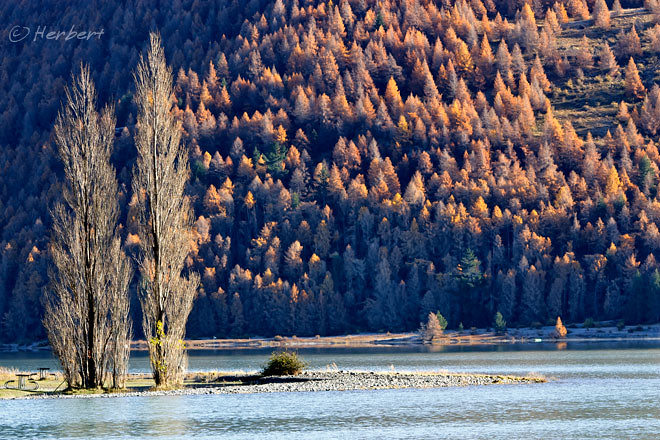
Location: Lake Tekapo, South Island, New Zealand (43° 53′ 0″ S, 170° 31′ 0″ E)
Date: 25 May 2009, 9.10am
Camera: Canon 300D with EF 70-200/f4 IS L
Lake Tekapo is one of the most pretty lake in the South Island of NZ. It is a popular spot for tourists on group/package tours. Every day one can see buses of tourists stopping off at the lakeside. However the tours normally only include a visit to the Church of the Good Shepherd on the shore of the lake; even though the lake has beautiful views across to the Southern Alps and beautiful forests along the shorelines. Furthermore there are great walks around the surrounding hills with views of the lake and its small islands from high. Most group/package tourists do not have the opportunity to enjoy such beauty. So if you are visiting Lake Tekapo, it is well-worth spending at least a night in the town.
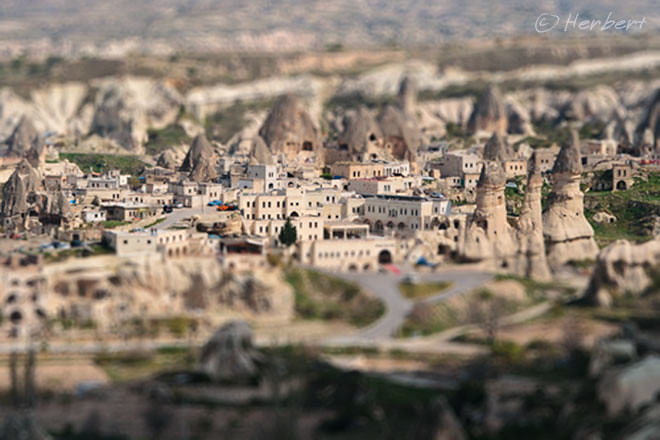
Location: Goreme, Cappadocia, Turkey (38° 40′ 0″ N, 34° 50′ 0″ E)
Date: 12 April 2010, 4.20pm
Camera: Canon 400D with Canon 70-200/f4L USM
Cappadocia is my favourite destination in Turkey. It is a really nice place to chill-out as one can trek or cycle out to see the beautiful rock formations and the fairy chimneys, marvel at the historical & cultural heritage in the caves or see the wonderful landscape from the air or just simply get immersed in the wonderful and weird surroundings of chimneys & caves. Of all the towns within the Cappadocia area, Goreme is my pick. It has all the amenities one need and cheap and fantastic accommodation. Furthermore the transportation from here to anywhere is marvellous. So if you were to visit Turkey, please do not miss Cappadocia; and if you are in Cappadocia, consider staying at Goreme.
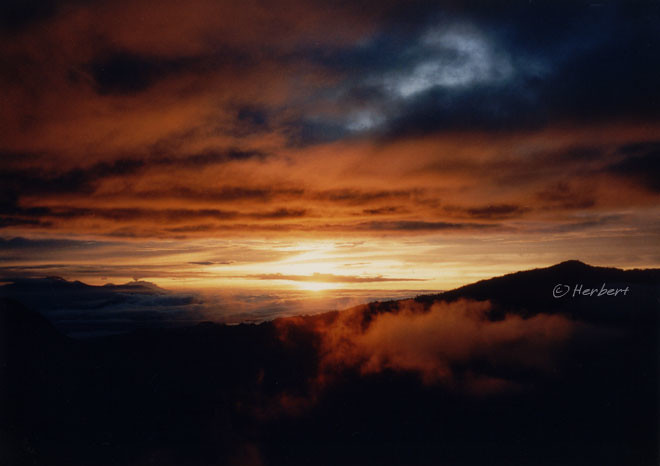
Location: Bromo-Tengger-Semeru National Park , East Java, Indonesia (7°45′8″S, 110°29′30″E)
Date: 25 December 1995; 5.50am
Camera: (analogue) Canon EOS 500N on negatives and scanned.
One of the most popular tourist destination on Java island Indonesia, has to be the Bromo-Tengger-Semeru National Park. The National Park offers great experience of proximity and view of a couple of mighty volcanoes, including the highest mountain, Mount Semeru, of Java. For the more energetic and adventurous (and I really mean adventurous) the National Park also offers an up-close-and personal encounter of the regular eruptions at the summit of Mount Semeru as well as an experience of standing above the clouds to enjoy a majestic sunrise view. Yet one can still enjoy a more laid-back, albeit early-rise and unforgettable Indonesia sunrise over the volcanoes from Gunung Penanjakan. However don’t forget your woollies- it is very cold at the mountainside at that time in the morning.
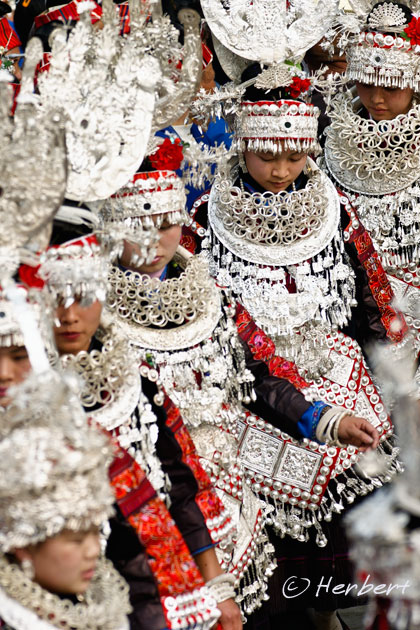
Location: Sister Meal Festival at Shidong, Guizhou, China (26°40'11.24"N,108°18'14.10"E)
Date: 24 April 2005; 4.50pm
Camera: Canon 300D with kit kens
Lately China had been struggling with their treatment of minorities with a few headline-grabbing incidents. In the last 3 years, there were riots in Tibetan Lhasa, ethnic conflicts in Uighur Urumqi and last month in Inner Mongolia. The problem is the way the Han Chinese perception of their own rule and reading and treating symptoms instead of causes. They are in a classic situation of being blind to their own defects. The resentment of Chinese Han Communist rule by the ethnic minorities in these provinces are so strong that a traveller has to be blind (or travel in a package tour) not to notice or hear about it in these places. But to be fair, not all ethnic minorities in China are hostile towards the Han Chinese majority. Minorities such as the Miaos and Zhuangs enjoy better quality of life now than they ever did in the past in China. They managed to maintain a lot of their culture and celebrate their festivals such as the Miao’s Sister Meal Festival, in ever grander fashion each year; so much so that these festivals are now major tourist attractions.

Location: Lake Inle at Nyaung Shwe, Myanmar (20°39′N 96°56′E)
Date: 18 December 2000; 5.15pm
Canon EOS 500N (analogue) on slides and scanned
Water transportation is the major means for people living around Lake Inle to get around. While today there are motorised and speedboats, most people still get around by rowing their boats. Lake Inle’s local residents are well-known for their unique technique of leg rowing. Standing up on one leg in the narrow stern of the boat, they wraps the other leg around an oar and, with a circular movement, propels his boat forward. This "leg rowing" gives them a better view of the waterways and makes it easier to navigate around the floating islands and water hyacinth which make the margins of the lake into a maze of passageways. This is especially useful for fisherman on the lake as the lake is covered by reeds and floating plants which makes it difficult to see above them while sitting. Standing provides the rower with a view beyond the reeds. leg rowing is only practiced by men; women rows by sitting cross legged at the stern and use only their hands to row.
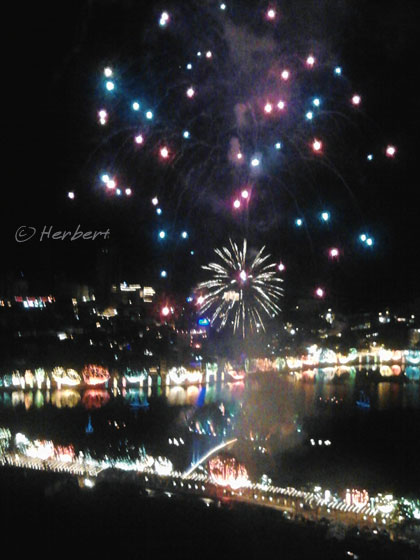
Location: Central Colombo, Sri Lanka (6°54'58.10"N 79°51'18.61"E )
Date: 17 May 2011, 7.40pm
Camera: Samsung Galaxy Mini phone camera
Vesak Day is a Buddhist holiday commemorating the birth, enlightenment and death of Gautama Buddha. It is celebrated on different days by different countries due to the diverse nature of Buddhist cultures around the world. In most South East Asian countries, it is a public holiday. On Vesak day, Buddhists will visit monasteries to offer their prayers and to attend sermons. In Sri Lanka, a Buddhist-majority country, Vesak is celebrated over a week, though there are only 2 days of public holiday. Here, it is not only a religious holiday but also a cultural festival, dubbed the “Festival of Lights”. Alcohol and meat are not sold for at least 2 days (the public holidays) during this period. There will be brightly-lit pandols called toranas erected all over the major cities such as Colombo and Kandy. One will often see long queues of people at food stalls called dansälas, set up by Buddhist devotees providing free food and drinks. There will be fireworks in Colombo. The week is the brightest-lit and most festive everywhere in Sri Lanka.
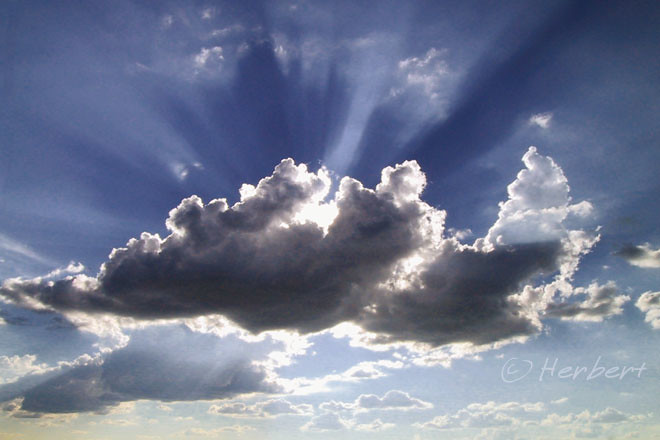
Location: Somewhere on the road in Namibia
Date: 19 April 2001; 5.45pm
Camera: (analogue) Canon 500N with slides and scanned
I have always been fascinated by the photos of African skies. There are such a variety- always either beautifully layered with clouds or blood-red sunsets tanning the landscape. It must be its weather system- large areas of dryness with seasonal deluge. In any case, I was not disappointed during my swing across the southern part of the continent as I have seen beautiful sunsets, misty mornings and many instances of the sun hiding shyly behind clouds. The sky is truly one of the attractions of Africa.

Location: The Haji Ali Dargah islet, Mumbai, India (18° 59′ 6″ N, 72° 48′ 36″ E)
Date: 11 April 2007; 4.40pm
Camera: Canon 400D with Sigma 17-70/f2.8-4.5
The Haji Ali Dargah is a landmark in the southern part of Mumbai. It is both a mosque and a tomb located on an islet off the coast on the Arabian Sea. The Haji Ali Dargah was constructed in 1431 in memory of a rich Muslim merchant, Sayyed Peer Haji Ali Shah Bukhari. Bukhari was from Bukhara, in the ancient Persian Empire and now in Uzbekistan, who gave up all his worldly possessions before making a pilgrimage to Mecca. He travelled around the world in the early to mid 15th century, and then settled in Mumbai.
Haji Ali Dargah is connected to the mainland by a narrow km long causeway that is submerged during tides; it is only accessible during low tides. This does not deter the 80,000 odd pilgrims, irrespective of faith and religion, who visits the tomb every week to get the blessings of the legendary saint. It is quite festive to visit the tomb on Thursdays and Fridays when it is packed with pilgrims and visitors. Occasionally there are also sufi musicians who perform sufi devotional music at the Dargah.
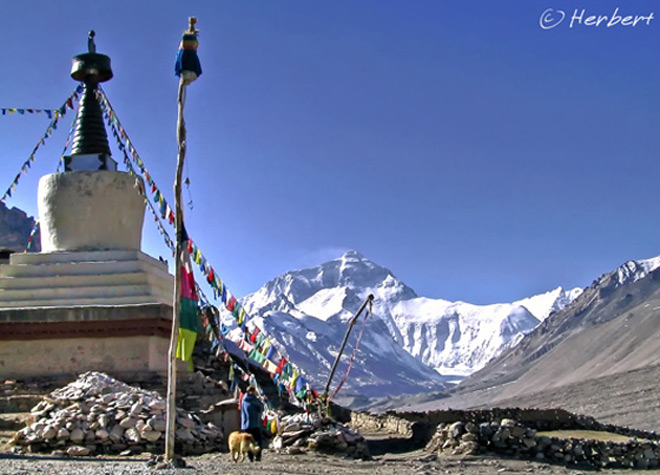
Location: Rhongbuk Monastery (5,100m), Tibet, China (28.194N, 86.829E)
Date : 27 April 2003; 10.25am
Camera : Canon G1
I always wanted to go back to see Mount Everest, either the Nepali or Tibetan (Chinese) side. Going to the Base Camp from the Chinese side has become much more easier in terms of transportation and access, but the problem now is in fact access to Tibet. I just applied for a visa to visit China and to my horror, instead of just one page of form to complete, I have to fill 7 pages now!! And unlike in the past, this must be accompanied by airline bookings (this was introduced just before the Olympics but was never taken off since). Travelling into Tibet is now ever more strict. Chances of getting in without a TTP and getting away is rather difficult as there are now numerous checkpoints and the guards are more vigilant. Perhaps I should try the cycling option next time- I think they are less likely to check cyclists- as long as one dressed more Chinese-like, and of course, have to look Chinese.
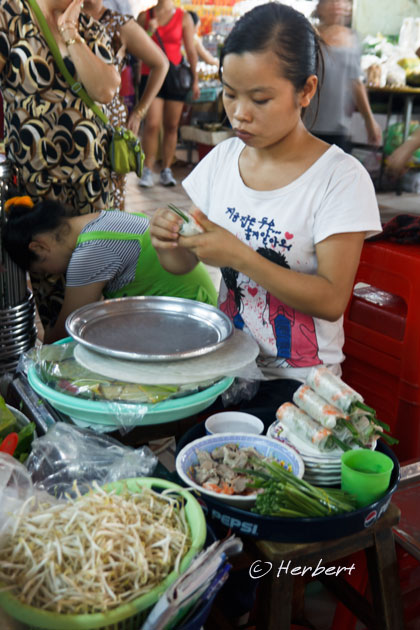
Location: Ben Thanh Market, Hi Chi Minh, Vietnam (10° 46′ 23″ N, 106° 41′ 54″ E)
Date: 20 May 2010, 9.15am
Camera: Canon 400D with Sigma 17-70/f2.8-4.5
There are not too many things to do in a big city, when one is traveling. Normally cities just serve as a transit point for transportation around the country or in/out of the country. Similarly I did not find Ho Chi Minh (HCM) interesting. If I follow the guidebooks’ recommendations, I will be visiting pagodas in HCM (see this post). However as in most Asian countries, there are 2 major attractions in cities like HCM- shopping and food. Well, what I meant by shopping is shopping for cheap-priced stuff, not the branded ones. Shopping-wise, it cannot compare to China but it has good interesting bargains and some products are unique and of better quality than those found in China.
Food-wise, Vietnam has a few unique dishes and delicacies. Vietnamese food generally is healthy, with lots of vegetables and less oil than the average Asian fares. No one can visit Vietnam without eating pho, the Vietnamese rice noodles- they are everywhere and in every meals. Pretty soon one gets sick of another bowl of pho, no matter how delicious it may be. Another Vietnamese dish that is present everywhere is gui cuon, which is a roll consisting of pork, shrimps, vermicelli and other ingredients wrapped in a clear rice paper. Gui cuon, which is also popularly known as Vietnamese summer roll, is like a spring roll except that is not fried and very fresh tasting. One of the better tasting gui cuon I had was in the food area of HCM’s biggest market, Ben Thanh Market.
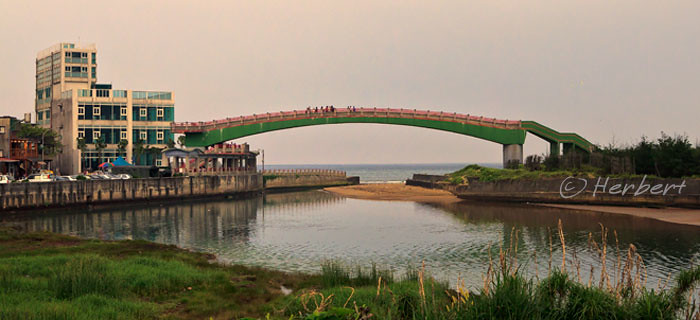
Location: Old Jinshan, Taiwan (25° 14′ 10″ N, 121° 37′ 3″ E)
Date: 3 May 2010, 4.15pm
Camera: Canon 400D with Sigma 17-70/f2.8-4.5
There are a few activities that will excite any visitors to Taiwan. One of them is to enjoy the numerous excellent hot springs dotted around the coast of the country. Taiwan lies on the edge of the Ring of Fire around the Pacific and has some earthquake and volcanic activities resulting in many hot springs. Taiwanese also has a traditional to soak in hot springs, perhaps partly influences from their Japanese colonial past. Many of these hot springs are developed into resorts and at certain times of the year, are crowded by domestic tourists. Old Jinshan (meaning Old “Gold Hill” reference to its previous glory days as a gold mining town) is one of such popular hot spring resorts. It is less than 2 hours north of Taipei and draw lots of visitors from the city during the weekends to enjoy its hot springs, sourced from the hills, as well as its local market and reasonably rustic shoreline.
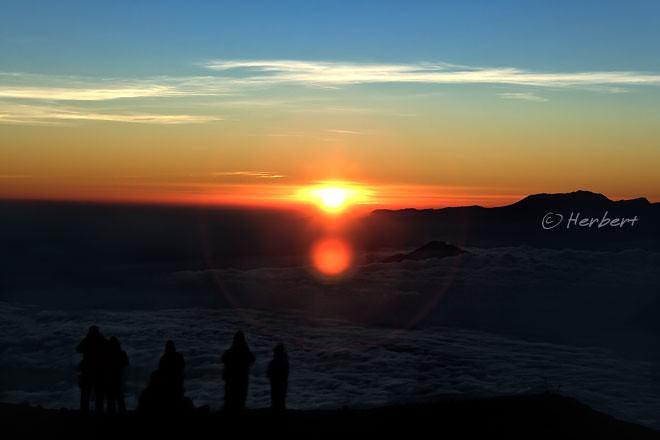
Location: At the summit of Mount Semeru, Indonesia (7°59'7.19"S 112°59'9.64"E)
Date: 18 July 2008; 6.15am
Camera: Canon 400D with Sigma 17-70/f2.8-4.5
One of the reasons people trek up to mountains is to enjoy the fabulous scenery and amazing sunset or sunrise. Mount Semeru is one of those places, as it is the highest mountain in Java. The sunrise at the top the peak is stupendous as one is virtually above the cloud covers. Often, depending on the direction of the sun, one can see his/her own shadow being casts on the clouds floating below them. Of course, one of the added excitement to trek up to the peak of Mount Semeru is the challenge (not easy to climb a volcano due to the deep ashes) and the adventure of standing beside a constantly-erupting active volcano. In fact lately it has been so actively erupting that the relevant authorities has banned any trekking to its summit.
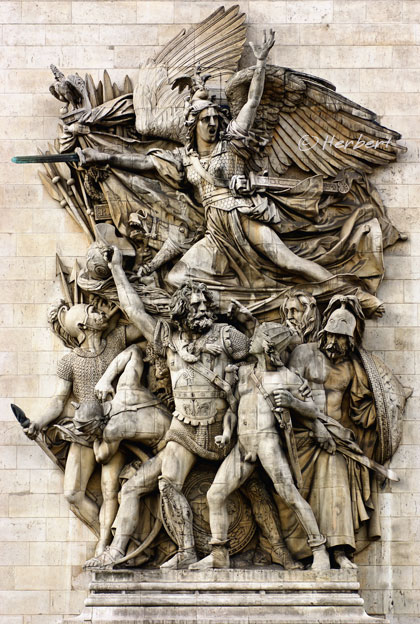
Location: Arc de Triomphe de l'Etoile, Paris, France, (48° 52′ 25.68″ N, 2° 17′ 42″ E)
Date: 2 March 2006; 1.30pm
Camera: Canon 300D with Sigma 70-200/f2.8
The Arc de Triomphe de l'Etoile is one of the few Paris landmarks that I have always wanted to visit when I was in that city. I have seen so many photos and read so much about this monument and it was not a disappointment to be at the site. The Arc was built over a long period of time mainly as a monument honouring those who fought and died for France in the French Revolutionary and the Napoleonic Wars. There are four sculptural groups at the base of the Arc, the most famous of which is the The Departure of the Volunteers of 1792 (or "La Marseillaise"). This composition depicts the French people rallying against enemies from abroad. This grouping so aroused spectators' patriotism that the work became known as "La Marseillaise," the French national anthem written in 1792--the same year as the departure of the volunteers. The sculpture is so vivid and alive that by itself, it is a precious work of art.

Location: K2 Base Camp, Pakistan (35° 44′ 0″ N, 76° 31′ 0″ E)
Date: 9 July 2007; 7.30am
Camera: Canon 400D with Sigma 17-70/f2.8-4.5
Pakistan is one of my favourite destinations. Its people are extremely hospitable and the mountain sceneries are just breath-taking. I may have wrote this before in this blog, to me, Pakistan’s Karakorum mountains are more beautiful and impressive than the Himalayas. They are more structured, muscular and full of characters. So it is with great sadness to read about the sufferings of this country and its people in the hands of Muslim extremists. Many innocents had been killed unnecessarily and many lives destroyed by the blind fanaticism of a few. I used to tell my friends not to worry about the news and all; one only read about the bad news and life in Pakistan is not as dangerous as one gets the impression from news reports. However, as the terrorist activities multiplied and multiplying with greater severity in the last six months, I am changing my opinion as to the safety of visiting the country. I still like to believe that at least things are saner in the mountain areas and it is still possible to enjoy the fresh air amongst the giant mountains.
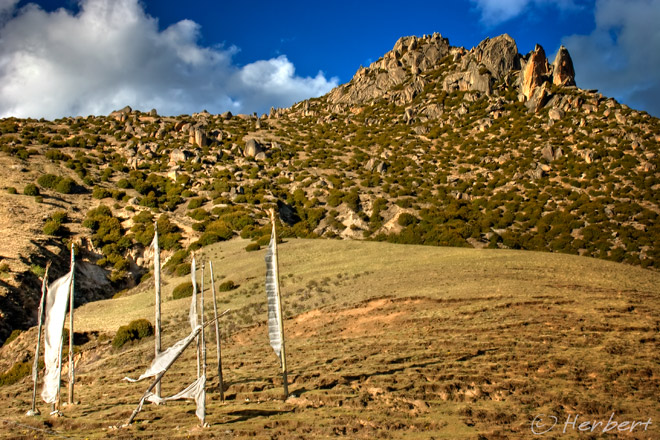
Locations: Rupuchaka Hot Springs, Sichuan, China (28° 46′ 0″ N, 100° 19′ 0″ E)
Date: 2 June 2004; 5.30pm
Camera: Canon 300D with kit lens
This Hot Springs is a few km from Daocheng, which is the gateway to the Yading Reserve. Yading Reserve is a major Tibetan pilgrimage site with 3 mountains considered sacred by Tibetan Buddhists. The Reserve has many snow-peak mountains and alpine lakes and is especially pretty in autumn. Like most beauty spots in China which are converted to Reserve, the whole process is messy. After the pasture has been converted to a Reserve, the activities of the people who lives there are heavily curtailed; but compensation was agreed based on a small % of the door intake. However apparently nothing was paid out and there were racial tension (the Reserve operators is a well-connected Han company while the Reserve and surrounding area is predominantly Tibetan) resulting in a couple of deaths. As a result the Reserve was closed to the public for a few years as the security establishment sort things out (which is normally not a pleasant thing in China). It has now been reopened for a couple of years. However with the recent deadly protests across Tibetan areas and the current protests at Kirti Monastery (which resulted in Tibetan deaths), Yading Reserve might be closed to foreigners soon as China customarily applies sledgehammer approach to balcking out of information about domestic problems.
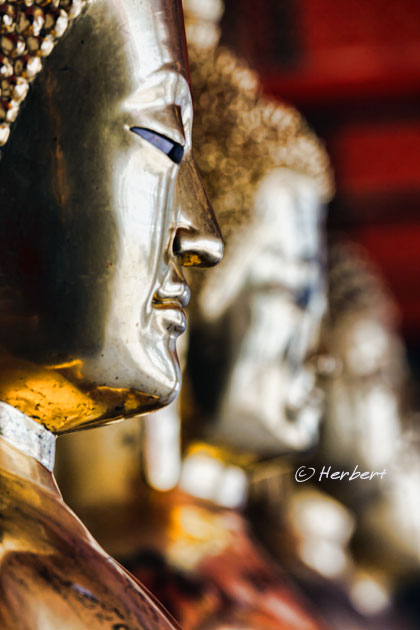
Location: Wat Pho, Bangkok, Thailand (13° 44′ 47″ N, 100° 29′ 37″ E)
Date: 24 June 2010, 1.35pm
Camera: Canon 400D with Canon 70-200/f4.0
One of the things I dislike about reading guidebooks such as Lonely Plant and Rough Guides is that they seem to always focus on one element of the places that they wrote about. If you read the book on Vietnam, the pages are filled with Pagoda this, Pagoda that and when one come to Thailand (apart from the islands), it is this Wat and that Wat. I guessed the guidebooks are written for a certain audience and that audience is people like me. I would be much more excited to read about things that are unique and local- sights and things that locals do- such as this article about Singapore. I do not suggest that it is inappropriate or irrelevant to focus on highlights such as local places of worship & endearment, it’s just that the average independent tourist- the target of such guidebooks- is more keen on discovering local going-ons than knowing where ALL the pagodas, wats etc are.
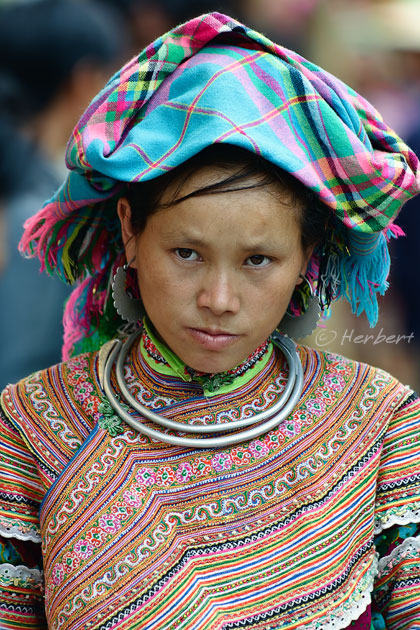
Location : Bac Ha Sunday Market, Vietnam (22° 33' 0 N 104° 16' 0 E)
Date : 5 June 2005; 9.20am
Camera : Canon 300D with Sigma 70-200/f2.8
I always try to visit the local markets wherever I travelled to. One reason for doing so is to satisfy my stomach as quite often the market is where one finds most of the unique local snacks and food at very cheap prices. It is also a good place to see and understand what the local people eats, what’s special fresh produce for the region and so on. However one of the major reasons I visit such markets especially the all-important weekly (or whatever regularity) market/bazaar is to mingle and see the ethnic people in their traditional costumes. In most of the remoter places, there are no regular morning market but only once on a certain day of the week or month. During this day, people who lives in the nearby villages will congregate here to buy, sell, eat, gossip and meet up with friends. And ethnic people in remote places also normally still wears their traditional costume every day. So whether the Yi’s of Yunnan, Uighurs of Xinjiang or Kashmiris Muslims, Market Day is an important date in their weekly or monthly routine.